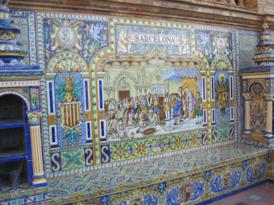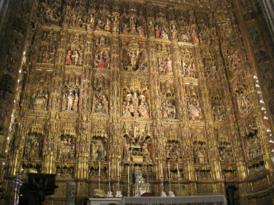To see the pictures, click the link to continue:
The next stop on our tour was the city of Seville, which is the site of the third largest cathedral in the world. In the years after the Reconquista, Seville became a wealthy trading port, and the city elites wanted to flaunt their status; the local legend is that they planned to build a church so large “that those who see it will think we were mad”. Work accordingly began in the 1400s, on the site of a former mosque that was badly damaged in an earthquake.
From the courtyard outside the cathedral’s main entrance, you can see the flying buttresses that were built to brace the walls against the church’s massive weight. (Even so, the massive central dome has collapsed at least twice due to smaller earthquakes.) The trees visible in the picture are wild orange trees, which grow on the streets in Seville. Appropriately, the courtyard is called the Patio de los Naranjos – it dates back to Moorish times, since before there was a cathedral on the spot, and was once used for worshippers to wash themselves before entering the mosque.
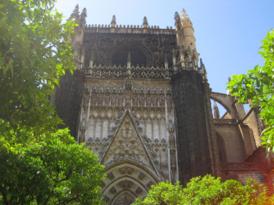 |
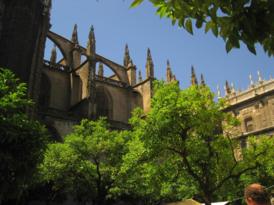 |
Inside, the sheer scale of the cathedral was vertigo-inducing, its massive vaults and arches inviting neck strain as tourists craned their heads to take it all in. I tried to take pictures that captured the feeling, but you’ll have to judge if I succeeded:
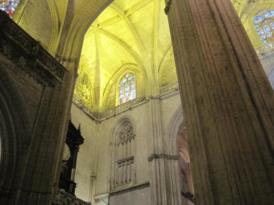 |
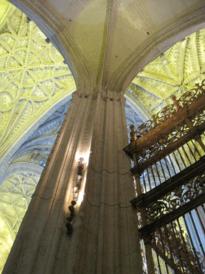 |
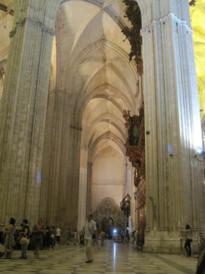 |
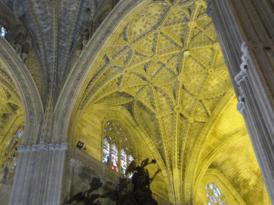 |
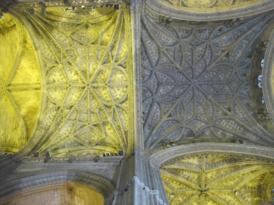 |
One of the cathedral’s claims to fame is that it’s the site of Christopher Columbus’ tomb. I was expecting a mausoleum in a secluded chapel, but it’s startlingly public – practically out on the floor of the cathedral nave. The actual tomb is an ornate lead casket held up high by four giant statues, representing the kings of the four medieval Spanish kingdoms of Castile, Leon, Aragon and Navarre, acting as pallbearers.
For all its pomp and glory, the size of the monument and the casket is a little misleading. Columbus’ body was exhumed and moved several times after his death, from Spain to the New World and back again, as the governors and elites of all the places he’d been to wanted the honor of having him buried there. By the time he was permanently interred here, I’m told, there was less than a kilogram of bone fragments left.
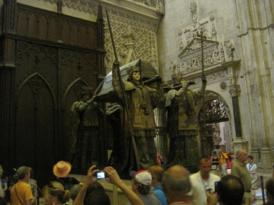 |
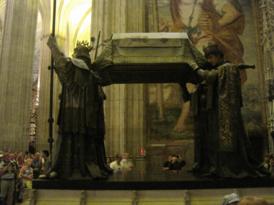 |
Columbus is still a national hero in Spain, despite a legacy that’s unsavory at best. When he landed in the so-called New World, he immediately embarked on a program of slavery and forced conversion to Christianity, with any Native Americans who wouldn’t go along tortured and killed. It didn’t escape my notice that the building of this cathedral was financed in large part by slave labor. The connection is most obvious when you see embellishments like this massive silver altar, which was probably built with precious metals obtained from American subjects:
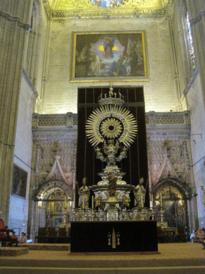
But even that wasn’t the most ostentatious part. In the chancel of the cathedral, behind the altar which was enclosed by iron scrollwork, was an immense retablo displaying forty-five separate scenes from the life of Jesus. Apparently, it was the work of a single craftsperson who took a lifetime – and, oh yes, it’s completely covered in gold:
Even more than at Córdoba, I was struck by how brazenly the Catholic church flaunts its enormous wealth. Beautiful art and architecture is one thing, but the church seemed to be going out of its way to stockpile and show off its riches as a means of exalting itself. Especially for a religious institution whose founder commanded its members to sell what they have and give it to the poor, this felt arrogant, callous and greedy in a world that still has so much need.
With all that said, the cathedral was quite beautiful when we returned to see it at twilight:
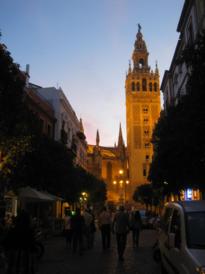 |
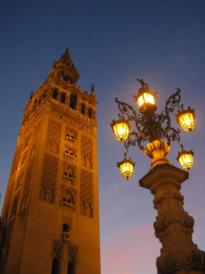 |
Next: Granada and the Alhambra.
